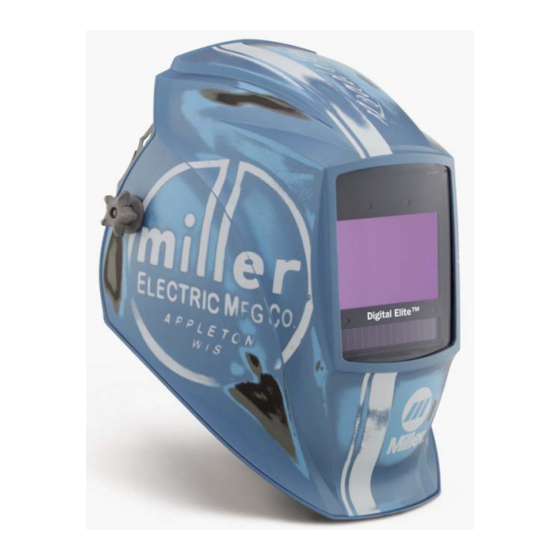Miller Digital Elite Manuel - Page 23
Parcourez en ligne ou téléchargez le pdf Manuel pour {nom_de_la_catégorie} Miller Digital Elite. Miller Digital Elite 32 pages. Auto-darkening helmets
Également pour Miller Digital Elite : Manuel (28 pages)

SECTION 9 − TROUBLESHOOTING
Trouble
Auto lens not On – auto-
lens does not darken mo-
mentarily when the On
button is pressed.
Not switching – auto-lens
stays light and does not
darken when welding or
cutting.
Not Switching – auto-lens
stays dark after the arc is
extinguished, or the auto-
lens stays dark when no
arc is present.
Sections of the auto-lens
are not going dark, distinct
lines separate the light and
dark areas.
Switching or Flickering –
the auto-lens darkens then
lightens while the welding
or cutting arc is present.
Inconsistent or lighter
auto-lens shading in the
dark-state, noticeable on
the outside edges and cor-
ners.
Check batteries and verify they are in good condition and installed
properly.
Check battery surfaces and contacts, and clean if necessary.
Check battery for proper contact and gently adjust contact points
if necessary. This is particularly important if the helmet has been
dropped. Verify left and right battery trays are installed on the
correct sides.
Stop welding or cutting immediately: Make sure the lens is turned
On.
If power is On, check the mode settings. Also review sensitivity
recommendations and adjust sensitivity if possible.
Clean lens cover and sensors of any obstructions. Make sure the
sensors are facing the arc; angles of 45_ or more may not allow
the arc light to reach the sensors.
Reduce Sensitivity setting (see Section 3-6). In extreme light con-
ditions, it may be necessary to reduce the surrounding light levels.
.
If the lens remains dark, press the Auto On/Off button to return
lens to the clear state.
Stop welding or cutting immediately: The auto-lens may be
cracked which can be caused by the impact of dropping the hel-
met.
Weld spatter on the auto lens may also cause cracking. (The lens
may need to be replaced; most cracked lenses are not covered by
warranty).
Review the sensitivity setting recommendations and increase the
sensitivity if possible. Be sure the arc sensors are not being
blocked from direct access to the arc light.
Check the lens cover for dirt and spatter that may be blocking the
arc sensors. Increasing Lens Delay 0.1 − 0.3 second may also
reduce switching.
Referred to as an angle of view effect, auto-darkening lenses
have an optimum viewing angle.
The optimum viewing angle is perpendicular or 90_ to the surface
of the auto-lens. When that angle of view varies in the dark-state,
welders may notice slightly lighter areas at the outside edges and
the corners of the lens. This is normal and does not represent any
health or safety hazard.
This effect may also be more noticeable in applications where
magnifying lenses are used.
Remedy
OM-256 476 Page 21
